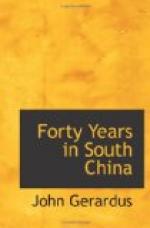“Our new church edifice was completed soon after Brother Pohlman left for Hongkong. As he had done so much of the work in gathering the congregation and had originated the idea of the building and had watched its erection with so much interest, we were desirous that he should be present at its consecration. We therefore delayed opening the building for worship until we received the definite news of his death.”
In an address on “Reminiscences of Missionaries and Mission Work,” delivered by Dr. Talmage during his later years, he refers to the early missionaries at Amoy in these words:
“The men God gave the Church were just the men needed to awaken her missionary spirit and shape her mission work. So for laying the foundation and shaping the plan of the structure He would have us erect at Amoy He gave us three men, just the men needed for the work,-David Abeel, William J. Pohlman and Elihu Doty. The more I meditate on what they said and wrote and did and suffered in the early days of that work, and see whereunto it is growing, the more am I impressed with the fact that they were wonderful men, just the men for the time, place, and circumstances, and therefore evidently God’s gift.
“Dr. Abeel was the pioneer of the Amoy Mission. During the greater part of the years of his manhood, he struggled with disease, and his whole life on earth was comparatively short, yet the Lord enabled him to accomplish more work than most men accomplish during a much longer life. His last field of labor was Amoy, entering it in January, 1842, when the port had just been thrown open and while the British army was still there, and leaving it in January, 1845. In that short time, notwithstanding interruptions from sickness and of voyages in search of health, or rather to stave off death till others were ready to take his place, he laid a good foundation, doing a work that told and was lasting. I met him only once. It was at his father’s house in New Brunswick, after his work at Amoy-after all his public work was done and he was only waiting to be summoned home. When I afterwards went to Amoy, I found his name very fragrant, not only among Europeans and Americans, but also among the Chinese. He had baptized none, but a goodly number of those afterwards baptized had received their first impressions concerning Christianity and their first instructions therein from him.”
“Messrs. Doty and Pohlman with their families came from Borneo to Amoy, arriving in June, 1844, about six months before Dr. Abeel was compelled to leave. We have heard of places so healthy, that it is said there was difficulty to find material wherewith to start cemeteries. Amoy, rather Kolongsu, where all the Europeans then resided, in those days was not such a place. It is said that of all the foreign residents only one escaped the prevailing fever. The mortality was very great. In a year and a half from the time of their arrival at Amoy, Mr. Doty




